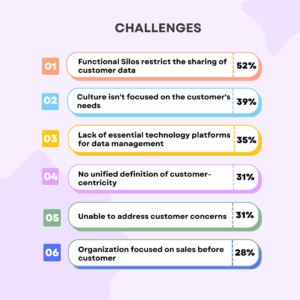Boost Your Business with a Customer-Centric Approach

A customer-centric business strategy emphasises delivering a positive consumer experience before and after the sale.
Why should businesses concentrate on this?
Enhancing customer loyalty and promoting business expansion are crucial for generating repeat business.
However, a customer-centric business requires more than simply providing excellent customer service.
While customer-centricity is a concept that must be encouraged and communicated across all levels of an organisation, it is not merely a phrase. Maintaining the customer as the focal point of all decisions and actions requires conscious effort.
Without being customer-centric, it is impossible to provide a seamless and quality customer experience. This article will discuss the benefits of putting the customer first and being customer-centric.
What is Customer Centricity?
Customer centricity is the art and science of delivering a strong value proposition that satisfies the constantly changing needs of customers, with the goal of establishing customer relationships based on loyalty and trust.
Customer-centric businesses focus their business models on customer requirements instead of competing with competitors’ offerings. They obtain a competitive advantage by providing customers with superior value that other companies cannot or will not provide.
In a few short years, a customer-focused business strategy has gone from optional to essential! Customer-centricity is the foundation of a successful growth strategy.
It pays to be customer-obsessed in order to remain relevant, beat the competition, and occupy mindshare. Customers are now able to swap brands at the drop of a hat due to the abundance of product and service options and endless choices.
With user experience (UX) emerging as the most significant differentiator, competition has effectively spread across industries, with brands competing over UX. Users expect the experience to be as simple as clicking an icon, regardless of whether they are browsing for shoes or comparing insurance policies.
Now, brands must have a deeper understanding of their customers than ever before in order to provide tailored and exceptional user experiences. It is of the utmost significance to accurately identify customers based on their current stage of the customer journey. In addition to this, it is possible to construct custom segments to deliver personalised content and offers. This 360-degree view of the customer depends heavily on collecting data from various sources and channels and analysing it to provide insights that can be used for genuine and personalised engagement.
The challenges of becoming a customer-centric company
During the late 1990s economic downturn, the balance of power between brand and customer changed as customers became more specific about which brands they invested their money with.
The winning brands were those that respected their consumers, provided superior service, and established long-lasting relationships with them.
Social media emerged as a game-changer during the same time period. Social media marketing transformed the ways in which customers interact with brands and became an integral part of the customer journey.
One in three customers discover new products, services, and brands via social media.
Social media is one of the many digital channels that are altering the relationship between businesses and customers.
Research demonstrates that companies struggling to become customer-centric are unable to communicate customer information across departments and lack a customer-centric culture.

Most organisations lack the components to claim customer-centricity, but the most crucial portion is:
Customer-centricity prioritises consumers’ needs and interactions with your business – not your products, features, and income model.
By developing your company from the customer’s perspective, you can meet their wants and provide a good experience.
How data-centricity can foster a customer-centric culture
While customer data is vital to create an extensive customer understanding, there is still considerable debate regarding its collection and usage. It is crucial for brands to be transparent about the data they acquire and how it affects the end user. To ensure department-wide consistency in compliance and authentication, it is necessary to implement certain procedures.
Next, a significant surprise: only 16% of businesses consider their data as excellent quality for several reports. It means what for the other 84%? Inaccurate, incomplete, and duplicate data, or bad data, limits data insights and breaks user experience. You need high-quality data to be data-driven in your goals and objectives.
Many customer-centric businesses are using big data to foster data management principles and skills. Instead of a large data pool, some companies employ cloud warehouses to load and store massive amounts of data. Even if your brand’s data pool is tiny, the concepts will apply regardless of your tech stack or business processes’ size, frequency, or complexity.
The digitization of many businesses across verticals has increased data volumes and the requirement for powerful data analysis. As more firms realise the need to find data collection avenues, enhance data, remove silos, and provide actionable insights, intelligent customer engagement systems will be in demand. To choose the right platform, you must understand its capabilities.
Five best practices for establishing a customer-centric business
Becoming a customer-centric business allows you to predict consumers’ needs and provide them with products and services that exceed their expectations.
Consider the words of Tim Cook, CEO of Apple: “Our whole role in life is to provide you with something you didn’t know you wanted. And once you get it, you cannot imagine life without it.”
Apple’s whole strategy relies around the customer. Customers fall in love with their product, and their Apple Centers offer world-class customer assistance to help them get set and walk through the door with a smile on their face.
As a result, a customer-centric brand produces products, processes, guidelines, and a culture that are meant to serve customers with a positive experience from the point of discovery through the point of purchase and further.
Here are five best practices to help your organisation stand out when it comes to customer-centricity:
- Hire for customer satisfaction. Employees are the front-facing people who will shape many consumer interactions. Regardless of function, prioritise hiring employees who are aligned with customer-centric thinking and the value of the customer experience at your business.
- Prioritise relationships. Customers are not simply numbers that can be evaluated and analysed in a revenue progress report. They are folks who profit immensely from establishing a mutually beneficial connection with you.
- Define your customer experience strategy. Your brand and business strategy inform your customer experience strategy. A brand strategy will outline exactly what people expect from your brand; a CX strategy will outline how you will meet those customer expectations.
- Customer data should be made more accessible. A new customer-centric strategy necessitates consolidated access to customer data and insights. A CRM database may help in providing a single interface that delivers better customer experiences by facilitating better knowledge of customers.
- Connect corporate culture to customer results. A customer-centric approach will encourage employees when actions can be linked to results. For example, real-time capture approaches to reduce customer wait times or make transitions easier for a customer might highlight effective strategy implementation.
Conclusion
The shift towards an organisation that is genuinely customer-centric is complex and time-consuming.
However, this should not discourage you, as even the smallest adjustments to policies and procedures can have a significant positive impact on both your employees and customers.
Being a customer-centric business is the Holy Grail of optimising customer value. Always place yourself in the customer’s shoes and enhance customer value while minimising customer effort.








